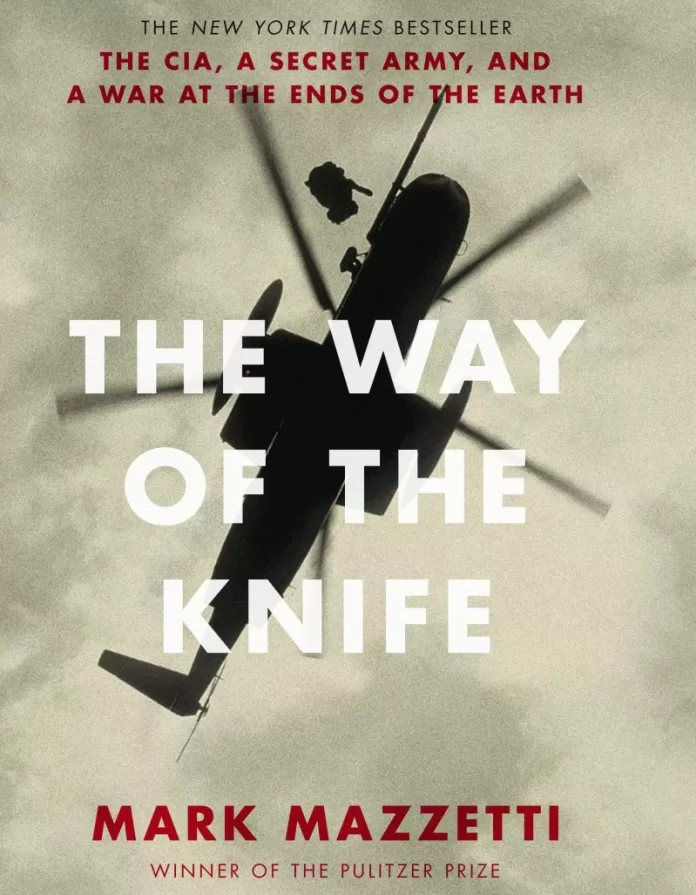Pulitzer Prize winner Mark Mazzetti’s book The Way of the Knife is a welcome addition to an increasing amount of work on ongoing conflicts. Mazzetti’s work is based on extensive research and interviews with key players in a secret war that is going on for the last decade.
The book provides details of debate within political, military and intelligence circles of Washington about controversial policies. He explains how CIA finally emerged as the ‘killing arm’ for the U.S. president and provides details of debate within CIA about the benefits and risks of the ‘kill them all’ policy. Career case officers and analysts were either ambiguous or against the program while the Counter Terrorist Division advocated and won the debate within the organization. The book also gives details of transformation of Pentagon and CIA where the former acquired many traits and tools of an intelligence organization while the later entered the battlefields flying paramilitary colors.
Mazzetti’s main sources are American therefore the book gives an American perspective of events. However, he provides some information about Pakistani actions too and some interesting details are provided about U.S.-Pakistan relations and its ups and downs in the last decade. In the immediate aftermath of September 11, relations between CIA and ISI were very cordial as the focus was on al Qaeda. ISI provided local support network while CIA opened its files on Arab militants to Pakistanis and set up sophisticated listening posts. The arrest of a large number of al-Qaeda operatives was the result of this close cooperation.
Mazzetti provides details of one of the most controversial policy of killing ‘enemies of the state’ using drones. There are strategic, tactical, legal and ethical dimensions of this debate and proponents and opponents of the policy give their views from their own vantage point. Contrary to popular belief, several factors contributed towards increased reliance on drones with the end result that at times it seems that it is the only tool in the arsenal to fight extremism.
Mazzetti explains how drone strikes to kill militants became the center piece of counter terrorism policy in Washington. The President wanted quick results with least amount of interference from other branches of government and the CIA ended up using a useful tool too often and at times too broadly thus negating the benefits. In the immediate aftermath of September 11, 2001, CIA was rounding up suspects and interrogating them in secret bases all over the world or outsourcing torture to other allies. As expected, very soon CIA looked like a correction department running jails. In the summer of 2004, an internal report by CIA’s inspector general severely criticized the agency’s policies with dire warning that these tactics could result in criminal prosecution of CIA officers. In 2005, Congress passed Detainee Treatment Act banning many techniques that CIA was using. Panic gripped the CIA and CIA director Porter Goss sent a letter to the White House stating that he was shutting down all investigations until the Justice Department gave judgment to make sure that CIA’s techniques were not breaching the law. Cumulative effect of all these measures resulted in shift of CIA from acting as ‘long term jailers of America’s enemies’ to a military organization that ‘could erase them’.
Once some senior leaders were taken out by drone strikes, CIA got mesmerized by this new toy. Some argue that this extensive focus on hunting and killing diverted attention from the primary task of intelligence collection and analysis. Giving ‘kill authority’ to an intelligence agency is a serious business and needs very careful evaluation as well as periodic assessment from outside to make sure that it stays in a very small box and organization does not loose its intelligence collection and analysis capacity. Israel normally does not acknowledge such subjects publicly but it is generally agreed that they went through a tortuous process long time ago. Intelligence agencies and judicial branch present their case about the deeds and potential risks of intended target to a special committee headed by Prime Minister. He is the final authority and decision is political and this violent instrument of state policy is used like other instruments at the disposal of the government. This ensures that ultimate responsibility rests with representatives of the people and those who pull the trigger are not acting in a rogue fashion but following strict set of rules. Discussion and debate in society about the ethical and moral aspects of the policy should ultimately guide their representatives.
Pakistan’s views about drones changed over time. Mazzetti’s work, Wiki Leaks cables and Bob Woodward’s books on wars provide details of Pakistan’s views about drones (some of them are corroborated by my own work about Pakistan army’s operations). The Pakistani army chief General Ashfaq Parvez Kayani asked Americans for a 24 hour surveillance of South Waziristan at a time when Americans didn’t have enough drones for expanding operations. When humbled by militant leader Nek Muhammad Wazir, Pakistanis went to Americans and told them, ‘If you guys can find him, go get him’. Pakistanis asked for taking out their bad guys and in return CIA asked for taking out their own bad guys roaming in Pakistan’s tribal areas. Militant leaders Nek Muhammad and Baitullah Mehsud were killed in drone strikes at Pakistan’s request and were called ‘goodwill strikes’.
Initially, Pakistan’s conditions included restriction of drone flights to specific ‘flight boxes’ over FATA, final approval of Pakistan for every strike and that drone fleet should be operated under covert authority of CIA so that either Pakistan could claim the kill or remain silent. When CIA rapidly escalated drone strikes going after even foot soldiers in Pakistan, the general public outrage made position of Pakistan army untenable. If strikes were with their permission then they were complicit in a policy deeply resented by society in general. If strikes were without their consent then they were viewed as unable to either convince Americans or worse, impotent to put a stop to strikes. As relations between U.S. and Pakistan deteriorated in 2011, Pakistan saw continued drone strikes as serious problem and asked for their cessation. The fact that Washington could not keep a secret came as a rude awakening for Pakistanis. They were probably not aware of the dictum that ‘Washington is the only ship that leaks from the top’. Leaks from top all the way to the bottom emanating from the policy making circles in Washington is the single most important factor that many allies are now very reluctant to confide with their American counterparts.

The drone is a tool of warfare like tanks, artillery and jet planes and like any instrument of war has its benefits and side effects. It is easy to be mesmerized by a new war toy and loose the bigger picture. On the other hand, it is also easy to denounce the tool because of its side effects or misuse. There is enough proof that compared to all other options, drones had the major impact on disrupting militant activities in Pakistan’s tribal areas. However, rather than restricting to only high value targets and using sparingly, when strikes became widespread targeting foot soldiers, Pakistan’s position became untenable and they asked to stop it. General public outrage against drone strikes on Pakistani territory put severe restraint on cooperation in many areas of even mutual benefit. The journey started when Pakistan asked for widespread surveillance by drones, provided bases for drones, asked for elimination of specific targets and claimed some of the strikes as its own. When U.S.-Pakistan relations deteriorated, Pakistanis first asked for slow down and finally cessation of drone strikes. The journey ended by Pakistanis asking Americans to pack up drone bases on its soil.
The debate in Washington about drones intensified in the last one year and finally President Obama recently announced transfer of all drone operations from CIA to the Pentagon. Now, its use will be very restricted and this tool will be used very sparingly. Many criticized drone program for lack of oversight but transfer to Pentagon does not answer this question. CIA operated it under covert operations but was required to brief House and Senate Intelligence Committees. The Pentagon will be operating it through Special Operations Command (SOCOM). President Bush had signed an executive order authorizing SOCOM to pursue terrorists where ever they are in the world. SOCOM will likely be using drones under this executive order and would not be required to report to intelligence committees of Congress. Practically there will be less oversight under the new arrangement from other branches of government.
In the past, deliberate efforts were made to shield the President from negative political fall out of covert operations conducted by CIA on President’s orders. In a complete reversal, the President now personally approves each target and specific strike that is quite unprecedented. There is no push back from Congress or judicial branch and general public opinion is not very averse to this policy therefore only restraint on the President will be diplomatic fallout from the operation. Only diplomats from Islamabad are strongly opposing the policy as it makes their job almost impossible.
A tactical weapon has an impact on strategy and just like introduction of artillery, tanks and fighter jets had an impact on the larger strategic canvass of the art of war, drones will also have a similar impact. Like tactical nuclear weapons, the production and deployment of drones are going at a fast pace before its role in strategy is figured out. We don’t have exact numbers but according to Lev Grossman of Time magazine, a decade ago, the Pentagon had fifty Unmanned Aerial Vehicles (UAV) but now have an inventory of over 7500. More than one third of U.S. force now consists of UAV. This clearly points to the fact that UAVs are here to stay. The conversation about their use has just started and there will be vigorous debate about the ethical, legal, tactical and strategic questions involving this new weapon. United States has set a very dangerous precedent and there will be far reaching consequences when other countries start to incorporate drones in their national security paradigm. In the absence of agreed international rules of war as applied to other weapons, if other countries start to use drones following the precedent set by the U.S. doctrine, only chaotic mess will be the logical outcome.
In the past, one had to wait twenty years for declassification of government files to understand the decision making process. However, in this age of good investigative journalism, whistle blowers and Wiki Leaks, we are learning about the art of covert war in real time. This book is a must read for anyone interested in the dynamics of a secret campaign spanning all over the globe with far reaching consequences for the world.





